
Imagine lying in the soft, green moss between the strong roots of a mighty tree. Your gaze wanders high up its trunk to its spreading crown. Lush green, its leafy cloak glows, sprouting with new strength in spring. A gentle wind plays amongst its branches. The Sun’s rays warm your skin, and you hear the tapping of a woodpecker somewhere. Birds twitter, insects hum, and on the ground beside you, you hear the crawling and rustling of tiny legs. The tree pulsates with life.
How much life there actually is, we only discover when we take a closer look. Every single tree gives life from the root, through the strong trunk, up to the highest leaf in its crown. The older and larger the tree, the more richly filled is the basket of its many gifts . So, join us now on a journey of discovery into the mysterious world of the tree:
When bugs go bathing
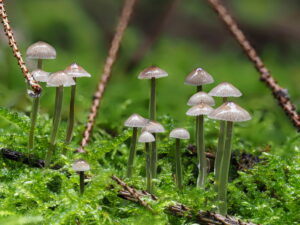
Even as a small seedling, the tree establishes relationships with other soil dwellers, such as bacteria and fungi. In particular, mycorrhizal fungi provide the tree with nutrients throughout its life and in exchange receive sugar as an energy source. This sugar is produced by the tree through photosynthesis in its leaves and is transported in the plant sap down to its roots. Once the tree is larger, each autumn, when the tree’s leaves fall to the ground, a banquet begins for the numerous microorganisms that live in the soil; springtails, mites, earthworms, woodlice, spiders and beetles feed on the falling leaves, producing fertile humus. The tree can reabsorb many of these nutrients thanks to the fungi.
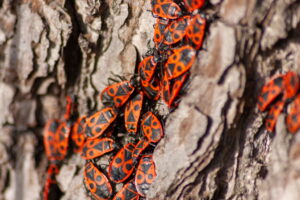 From the roots, the tree trunk grows high into the sky. When the Sun shines on the trunk, heat-loving insects such as bees, wasps, butterflies, bugs and beetles like to take a break there and take a sunbath. In particular, the red fire bugs meet on warm tree trunks and also perform their mating there. With older trees, the bark becomes weaker in some places or splits open. Beetles feel snug and safe in these cracks and gnaw their burrows. Bats look for night or winter quarters in particularly wide cracks under the bark. Mice, foxes or badgers sometimes make their burrows under the strong roots to be better protected from rain and cold.
From the roots, the tree trunk grows high into the sky. When the Sun shines on the trunk, heat-loving insects such as bees, wasps, butterflies, bugs and beetles like to take a break there and take a sunbath. In particular, the red fire bugs meet on warm tree trunks and also perform their mating there. With older trees, the bark becomes weaker in some places or splits open. Beetles feel snug and safe in these cracks and gnaw their burrows. Bats look for night or winter quarters in particularly wide cracks under the bark. Mice, foxes or badgers sometimes make their burrows under the strong roots to be better protected from rain and cold.
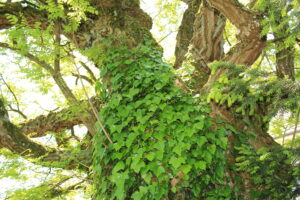 Ivy or other climbing plants twine around the tree trunk in an attempt to catch a little sunlight in the shady forest. However, they do not harm the tree in the process. The dense foliage of these climbing plants provides additional living space where birds can nest or where bats, dormice, hazel dormice or squirrels can hide. Ivy is one of the few plants that continues to flower late into the year, sometimes well into December, offering bees the last sugar-rich nectar of the year. The berries that appear shortly afterwards are valuable winter food for many bird species.
Ivy or other climbing plants twine around the tree trunk in an attempt to catch a little sunlight in the shady forest. However, they do not harm the tree in the process. The dense foliage of these climbing plants provides additional living space where birds can nest or where bats, dormice, hazel dormice or squirrels can hide. Ivy is one of the few plants that continues to flower late into the year, sometimes well into December, offering bees the last sugar-rich nectar of the year. The berries that appear shortly afterwards are valuable winter food for many bird species.
One cavity for many
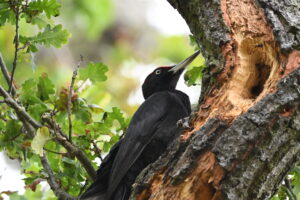
A tree cavity is a very special habitat that only develops its full potential over time. It all begins with the woodpecker, which decides to build a new nest. However, the hole that it hammers high up in the tree trunk is still too narrow for the bird in the first year, so it leaves it to the wood-decaying fungi to work their way into the wood for a few years. Wood-eating beetles follow and feed on the rotten wood. Eventually, the cavity has become so large that, after a little house cleaning, the woodpecker or another bird species, along with the whole family, can move in. Over the years, these comfortable living quarters become more and more spacious, providing a place for a wide variety of bird and bat species to raise their young. Eventually, the tree cavity is large enough to even hold the winter supply of honey for an entire bee colony; the bees will then remain in the tree cavity for many years.
A biotope in the tree canopy
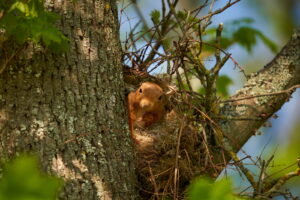
The busiest bustle of larger animals can be observed in the tree canopy. Squirrels build so-called Kogel, balls of twigs and leaves, for the rearing of their offspring. Birds build their nests in the branches out of twigs and grass and sing to the competition. Rainwater collects in the crotches of some branches. These small bathing and drinking places for birds are also tiny biotopes and are quickly colonised by microorganisms. Birds of prey like to perch on the uppermost branches of the tree, where they have the best overview and can look out for prey.
Aphids suck the sweet plant sap from leaves and young twigs. Often enough, the aphids themselves end up as a tasty snack for a hungry bird. However, during their short lives, they have an army of protectors: the ants. These are very interested in the sweet, sugary secretions of the aphids. In exchange for the tasty plant sap, the ants guard and protect their flock of aphids from predatory insects.
Many a butterfly or moth caterpillar also fills its belly with leaves in the treetops before pupating and later emerging as a magnificent butterfly. And the blossoms are visited by bees and other pollinating insects such as wasps, hoverflies and beetles, which come to snack on the nectar and collect pollen.
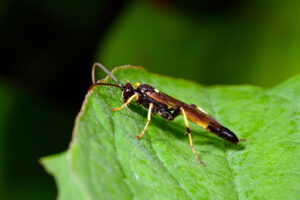 All the animals in the tree need food. The majority of this is found on ‘their’ tree in the form of nectar, pollen, fruits and leaves, as well as deadwood, or they eat the insects living in the tree. When a branch breaks off and falls to the ground, a very slow decomposition process begins, thanks to which a wide variety of insects that feed on dead and rotten wood can live. Wood beetles, wasps and bees eat their way through the wood or lay their eggs there. Some beetle larvae pupate and develop very slowly over several years before they finally see the light of day. In turn, parasitic wasps feed on these insect larvae if they are lucky enough to get to them.
All the animals in the tree need food. The majority of this is found on ‘their’ tree in the form of nectar, pollen, fruits and leaves, as well as deadwood, or they eat the insects living in the tree. When a branch breaks off and falls to the ground, a very slow decomposition process begins, thanks to which a wide variety of insects that feed on dead and rotten wood can live. Wood beetles, wasps and bees eat their way through the wood or lay their eggs there. Some beetle larvae pupate and develop very slowly over several years before they finally see the light of day. In turn, parasitic wasps feed on these insect larvae if they are lucky enough to get to them.
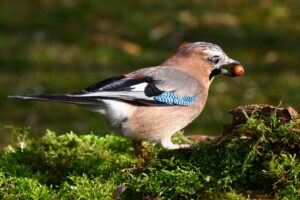 The fruits that appear in late summer thanks to pollination are one of the most precious gifts of the tree to all its inhabitants for whom it so generously cares. If the tree is lucky, an eager jay or a hard-working squirrel will carry its fruits to a hiding place in the ground and forget the supply, allowing the small seed to germinate there.
The fruits that appear in late summer thanks to pollination are one of the most precious gifts of the tree to all its inhabitants for whom it so generously cares. If the tree is lucky, an eager jay or a hard-working squirrel will carry its fruits to a hiding place in the ground and forget the supply, allowing the small seed to germinate there.
And so a new tree begins its life, and in about 100 years it will provide a home and food for as many living creatures as the tree from which it came once did. Isn’t the world full of wonders?









